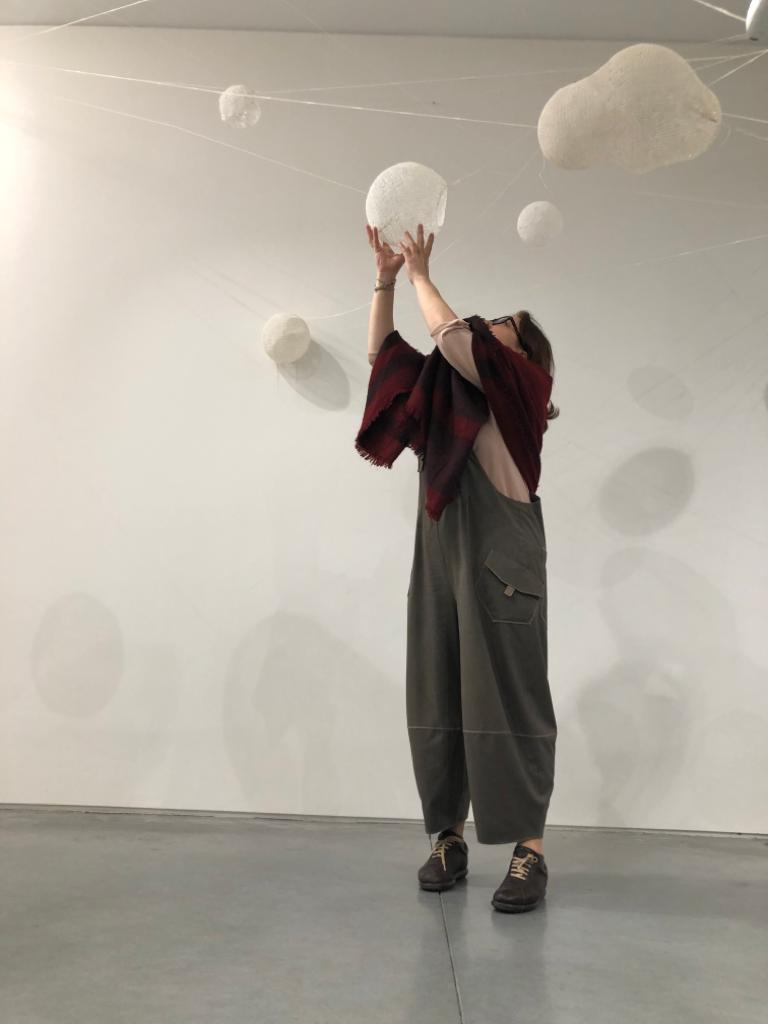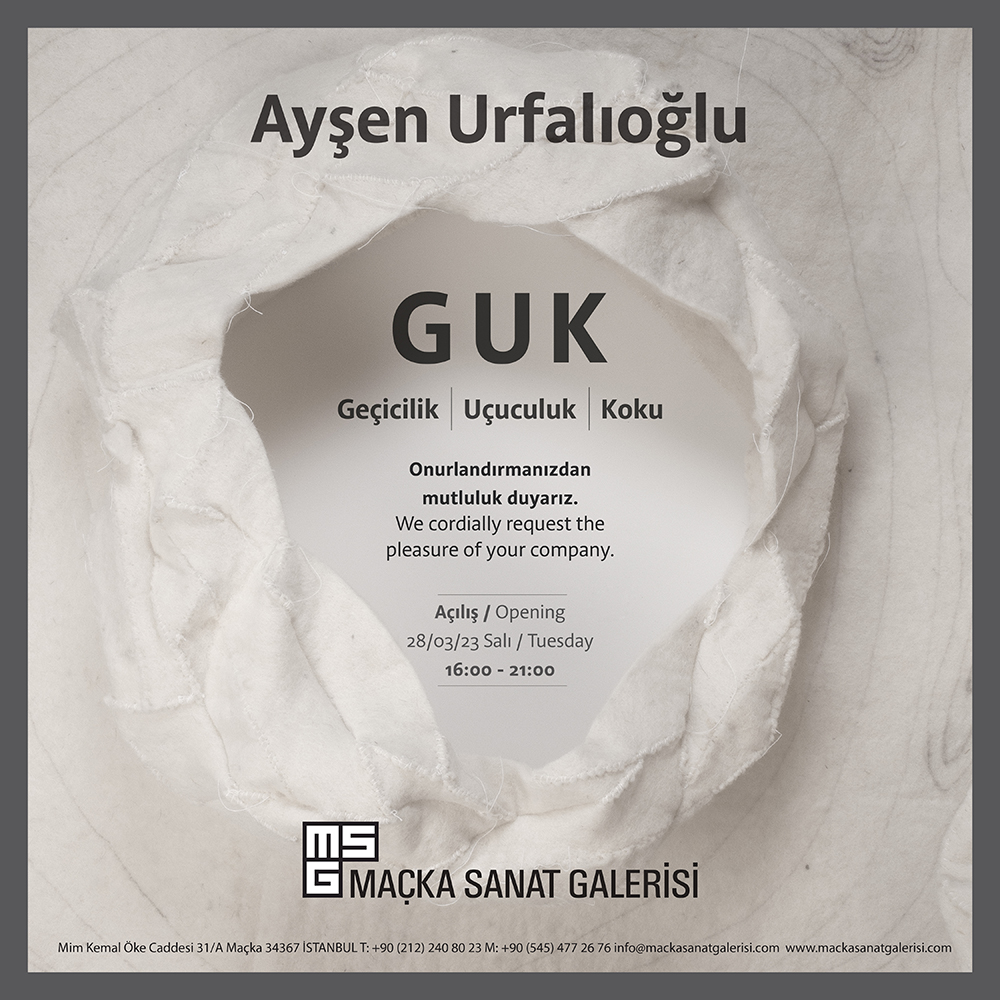Ayşen Urfalıoğlu
I was born in 1967 in Istanbul. My primary and secondary school years were spent in various regions of the country, immersed in very different cultures and attending different schools. At that age, it was challenging, yet it taught me how to live under many different conditions and social environments. When we were reassigned, we would leave one city in tears and, two years later, leave the next city in the same way. The diverse cultures, people, perspectives, smells, foods, games, and experiences of my childhood hold an important place in my imagination and personal development. During my childhood, my mother’s nearly constant work as a seamstress, along with the stories she told, deeply influenced me—something I only fully understood later, when I entered professional life. Needle, thread, and fabric have become materials I use regularly in my art, alongside paint.
In 1984, after studying business through open education and working at Denizcilik Bank for three years, I entered Marmara University, Faculty of Fine Arts, Painting Department in 1987, as my only choice. Studying another department would have made no sense. Even in high school math classes, I often drew my notes to understand the subjects. All my books were filled with drawings from teachers and classmates, and wherever I found space, I would draw—on newspapers, books, notebooks, and even the walls of my room (although I could only draw with chalk so I could erase it later). The influences of my past began to surface through my early schoolwork. At that time, a hands-on approach, combined with free association and the use of materials like needle, thread, tulle, and translucent fabrics, facilitated the expression of my ideas due to their novelty and depth.
Sewing, attaching, combining parts into a whole, and knotting can be read analytically. Unlike paint, these techniques pierce the surface, allowing perception from both sides. Every form created this way becomes visible from both sides, breaking boundaries while adhering to the surface. They fix, patch, and repair. I cannot always define precisely what I aim to fix through my work, but there are scents, people, and memories I never want to lose—my children, my family, trees, water, my needles, threads, fabrics, books, Cello Suite by Yo-Yo Ma, our cat Osman…
I have always been curious and read anything I could find, particularly scientific articles, essays, biographies, and true stories. As I delved into art, my reading priorities shifted between psychology, philosophy, and sociology. When I developed my own working method, I chose to base my work on images inspired by books and ideas I internalized rather than copying a specific artist or style. I still work this way. My works take shape over long-term engagement with a subject, influenced by all I have read and absorbed.
During my school years, I participated in many competitions, sometimes winning awards, sometimes being exhibited. I also attended numerous events and fairs organized to support talented young artists. During an exhibition organized by Genç Etkinlik, a jury of prominent artists and gallery owners invited me to participate in Maçka Art Gallery’s 20th-anniversary events. At that point, my school years were over. As a young artist, it was very difficult to work with any gallery at the time, as only a few galleries were well-established. After seeing the exhibition space and conceptualizing my work (Covered Identity), I began a lasting collaboration with Maçka Art Gallery. The gallery, its prominent artists, and Rabia Çapa played a significant role in shaping my artistic development and perspective.
In 2000, our family experienced a major trauma—a nightmarish accident, saying goodbye to my son, followed by severe depression. I returned to life through my work. When I started working intensively, many things changed. I focused obsessively on a single subject: Scent. I read everything I could on the subject. Scientific sources were limited because modern science had largely postponed its study. The motivations for my work were my children, my readings, and my experiences. It was a unique project in terms of both scent and production. With the help of chemists in a laboratory, we worked tirelessly to achieve the desired purity and simplicity. Ultimately, I created 900 hand-carved lambs, using the excess material to create the ground. In the gallery space, I performed and recorded the installation in one shot, ensuring the lambs were the appropriate size for exhibition. The gallery also displayed my research on scent receptors and literature in the background.
While literature has always fascinated me, the most important factor in my work is not merely intellectual or scientific influence. It is topics that I internalize, that resonate deeply and emotionally, which guide my creations.
In 2004, I performed for hours in an international exhibition curated by Inge Becker, “Meeting Point Contemporary Art: Turkish-Greek Exhibition” at Aya İrini. I cut my son’s clothes into tiny pieces, recording them in a single shot. I scattered the fragments on stage and wrote “how much will go, how much will remain”. The exhibition later traveled to Leverkusen, Germany, and the Museum of Contemporary Art, Macedonia, Greece.
I have participated in numerous solo and group exhibitions. Some works ignite a fire within that lasts for years. At the Cholet Museum in France, I participated in the exhibition “Du Bosphore à la Moin” alongside 900 lambs and two video works, alongside prominent French and Turkish artists such as François Morelle, Daniel Buren, Sarkis, Altan Gürman, and Candeger Furtun.
Working meticulously and patiently, concentrating on the meaning I imbue in my work, and allowing the process to evoke feelings in me—while sometimes leaving work intentionally incomplete—has always been a path I cannot abandon. The sense of incompletion or imperfection fascinates me.
In the 2010s, in an autobiographical series pierced with needles, the sewn sensory organs were hollow, and the hand stitching with colorful metallic threads was my own. I wove the threads into chains or cell shapes and integrated them into my works, always ensuring connections to prior or subsequent pieces. Curiosity often led me to explore unexpected directions.
By 2017, I continued my work along the same lines. Over the past three years, I have been exploring the Attachment Theory inspired by scent—what is attachment, why is it so important? I was particularly influenced by John Bowlby’s studies, which emerged from post-WWII research and clinical experiments. For me, scent is deeply significant: is it for connection, security, a sense of existence, or the drive to create? Exploring the fundamental drives and emotions that underpin survival and struggle has led me to a fascinating place. Everything grows, leaps, and multiplies through holding on. I intend to fully explore this in a forthcoming project. The observations and discoveries I made during this research are incredibly exciting to me.


